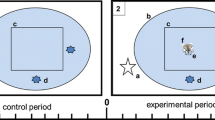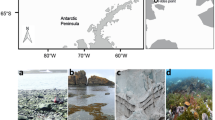Abstract
Populations of hermit crabs are critically limited by the availability of suitable gastropod shells that they utilise to reduce their risk of predation and environmental stress. Common whelks are the main source of shells for large hermit crabs in the northern Atlantic but are vulnerable to direct and indirect effects of fishing activity. This study examined the potential consequences of degrading shell resources for common hermit crabs. Laboratory trials demonstrated that hermit crabs avoid low-quality damaged shells throughout their life history. This laboratory preference was corroborated by direct field observations of shells preferentially occupied by hermit crabs, compared with shells available for occupation. In the field, 8 times as many empty shells had holes compared to shells occupied by hermit crabs. In the North Sea, the abundance and biomass of live whelks and hermit crabs collected at sites where they co-occurred were significantly related. However, whelks occurred at far fewer sites overall and were more patchily distributed at high abundance than hermit crabs, which were more widespread. At a subset of sites, whelks of the same body-mass range occurred in the Irish and North Sea. However, at these sites, hermit crabs sampled from the North Sea had a significantly lower biomass. This suggests that the shells available for occupation at the North Sea sites would not support crabs of a body mass comparable to that found in the Irish Sea. Using published data, we calculated that in some of the intensively fished areas of the North Sea, 24% of the available shell resource will be damaged each year. The reduction in shell quality in the North Sea may impose a physical constraint on the upper size limit currently attainable by hermit crabs and hence may have implications for population viability.





Similar content being viewed by others
References
Angel J (2000) Effects of shell fit on the biology of the hermit crab, Pagurus longicarpus (Say). J Exp Mar Biol Ecol 243:169–184
Berghahn R (1990) On the potential impact of shrimping on trophic relationships in the Wadden Sea. In: Barnes M, Gibson RN (eds) Trophic relationships in the marine environment. Proceedings of the 24th European marine biology symposium. Aberdeen University Press, Aberdeen, pp 130–140
Bergman MJN, Santbrink JW van (1994) Direct effects of beam trawling on macrofauna in sandy areas off the Dutch coast. In: de Groot SJ, Lindeboom HJ (eds) Environmental impact of bottom gears on benthic fauna in relation to natural resources management and protection of the North Sea. Netherlands Institute for Sea Research, Den Burg, The Netherlands, pp 209–236
Callaway R, Alsvåg J, Boois D, Cotter J, Ford A, Hinz H, Jennings S, Kröncke I, Lancaster J, Piet G, Prince P, Ehrich S (2002) Diversity and community structure of epibenthic invertebrates and fish in the North Sea. ICES J Mar Sci 59:1199–1214
Collie JS, Escanero GA, Valentine PC (1997) Effects of bottom fishing on the benthic megafauna of Georges Bank. Mar Ecol Prog Ser 155:159–172
Collie JS, Hall SJ, Kaiser MJ, Poiner IR (2000) A quantitative analysis of fishing impacts on shelf-sea benthos. J Anim Ecol 69:785–799
Conover MR (1978) The importance of various shell characteristics to the shell-selection behaviour of hermit crabs. J Exp Mar Biol Ecol 32:131–142
Côté IM, Reverdy B, Cooke PK (1998) Less choosy or different preference? Impact of hypoxia on hermit crab shell assessment and selection. Anim Behav 56:867–873
Dulvy NK, Reynolds JD (2002) Predicting extinction vulnerability in skates. Conserv Biol 16:440–450
Dulvy NK, Metcalfe JD, Glanville J, Pawson MG, Reynolds JD (2000) Fishery stability, local extinctions, and shifts in community structure in skates. Conserv Biol 14:283–293
Duplisea DE, Jennings S, Warr KJ, Dinmore TA (2002) A size-based model for predicting the impacts of bottom trawling on benthic community structure. Can J Fish Aquat Sci 59:1785–1795
Elwood RW, Neil SJ (1992) Assessments and decisions: a study of information gathering by hermit crabs. Chapman and Hall, London
Elwood RW, Marks N, Dick JTA (1995) Consequences of shell-species preferences for female reproductive success in the hermit crab Pagurus bernhardus. Mar Biol 123:431–434
Groenwold S, Fonds M (2000) Effects on benthic scavengers of discard and damaged benthos produced by the beam-trawl fishery in the southern North Sea. ICES J Mar Sci 57:1395–1406
Hayward PJ, Ryland JS (1995) Handbook of the marine fauna of north-west Europe. Oxford University Press, Oxford
Jackson JBC, Kirby MX, Berger WH, Bjorndal KA, Botsford LW, Bourque BJ, Bradbury RH, Cooke R, Erlandson J, Estes JA, Hughes TP, Kidwell S, Lange CB, Lenihan HS, Pandolfi JM, Peterson CH, Steneck RS, Tegner MJ, Warner RR (2001) Historical overfishing and the recent collapse of coastal ecosystems. Science 293:629–638
Jennings S, Reynolds J, Mills S (1998) Life history correlates of responses to fisheries exploitation. Proc R Soc Lond B 265:333–339
Jennings S, Lancaster JE, Woolmer A, Cotter J (1999) Distribution, diversity and abundance of epibenthic fauna in the North Sea. J Mar Biol Assoc UK 79:385–399
Jennings S, Dinmore TA, Duplisea DE, Warr KJ, Lancaster JE (2001) Trawling disturbance can modify benthic production processes. J Anim Ecol 70:459–475
Kaiser MJ, Spencer BE (1995) Survival of by-catch from a beam trawl. Mar Ecol Prog Ser 126:31–38
Kaiser MJ, Hill AS, Ramsay K, Spencer BE, Brand AR, Veale LO, Prudden K, Rees EIS, Munday BW, Ball B, Hawkins SJ (1996) Benthic disturbance by fishing gear in the Irish Sea: a comparison of beam trawling and scallop dredging. Aquat Conserv Mar Freshw Ecosyst 6:269–285
Kunitzer A, Basford DJ, Craeymeersch JA, Dewarumez JM, Dorjes J, Duineveld GCA, Eleftheriou A, Heip C, Herman P, Kingston PF, Niermann U, Rachor E, Rumohr H, Wilde PAJD (1992) The benthic infauna of the North Sea: species distribution and assemblages. ICES J Mar Sci 49:127–143
LaBarbera M, Merz RA (1992) Postmortem changes in strength of gastropod shells: evolutionary implications for hermit crabs, snails and their mutual predators. Palaeobiology 18:367–377
McClintock TS (1985) Effects of shell condition and size upon the shell choice behaviour of a hermit crab. J Exp Mar Biol Ecol 88:271–285
Mensink BP, Fischer CV, Cadee GC, Fonds M, Ten Hallers-Tjabbes CC, Boon JP (2000) Shell damage and mortality in the common whelk Buccinum undatum, caused by beam trawl fishery. J Sea Res 43:53–64
Pechenik JA, Lewis S (2000) Avoidance of drilled gastropod shells by the hermit crab Pagurus longicarpus at Nahant, Massachusetts. J Exp Mar Biol Ecol 253:17–32
Pechenik JA, Hsieh J, Owara S, Wong P, Marshall D, Untersee S, Li W (2001) Factors selecting for avoidance of drilled shells by the hermit crab Pagurus longicarpus. J Exp Mar Biol Ecol 262:75–89
Philippart CJM (1998) Long-term impact of bottom fisheries on several by-catch species of demersal fish and benthic invertebrates in the south-eastern North Sea. ICES J Mar Sci 55:342–352
Ramsay K, Kaiser MJ (1998) Demersal fishing increases predation risk for whelks Buccinum undatum (L.). J Sea Res 39:299–304
Ramsay K, Kaiser MJ, Hughes RN (1996) Changes in hermit crab feeding patterns in response to trawling disturbance. Mar Ecol Prog Ser 144:63–72
Ramsay K, Kaiser MJ, Moore PG, Hughes RN (1997) Consumption of fisheries discards by benthic scavengers: utilisation of energy subsidies in different marine habitats. J Anim Ecol 86:884–896
Reese ES (1962) Shell selection behaviour of hermit crabs. Anim Behav 10:347–360
Rijnsdorp AD, Buijs AM, Storbeck F, Visser E (1998) Micro-scale distribution of beam trawl effort in the southern North Sea between 1993 and 1996 in relation to the trawling frequency of the sea bed and the impact on benthic organisms. ICES J Mar Sci 55:403–419
Rumohr H, Kujawski T (2000) The impact of trawl fishery on the epifauna of the southern North Sea. ICES J Mar Sci 57:1389–1394
Acknowledgements
We are grateful to C. Prout and P. Ratcliffe for assistance with behavioural observations.
Author information
Authors and Affiliations
Corresponding author
Additional information
Communicated by J. P. Thorpe, Port Erin
Rights and permissions
About this article
Cite this article
Kaiser, M.J., Hinz, H., Callaway, R.M. et al. Resource degradation: a subtle effect of bottom fishing. Marine Biology 146, 401–408 (2005). https://doi.org/10.1007/s00227-004-1440-5
Received:
Accepted:
Published:
Issue Date:
DOI: https://doi.org/10.1007/s00227-004-1440-5




